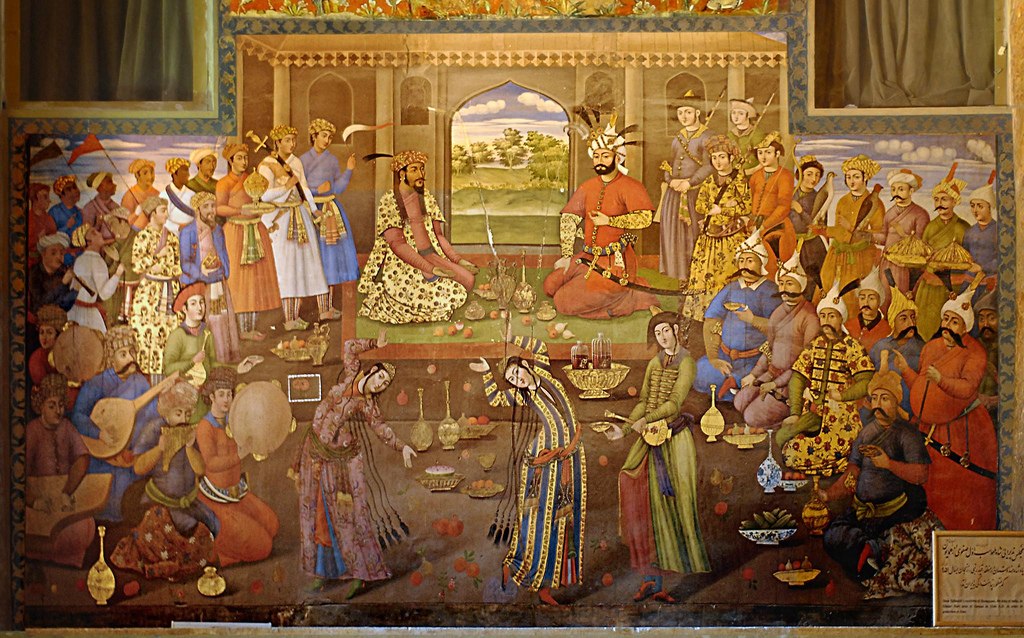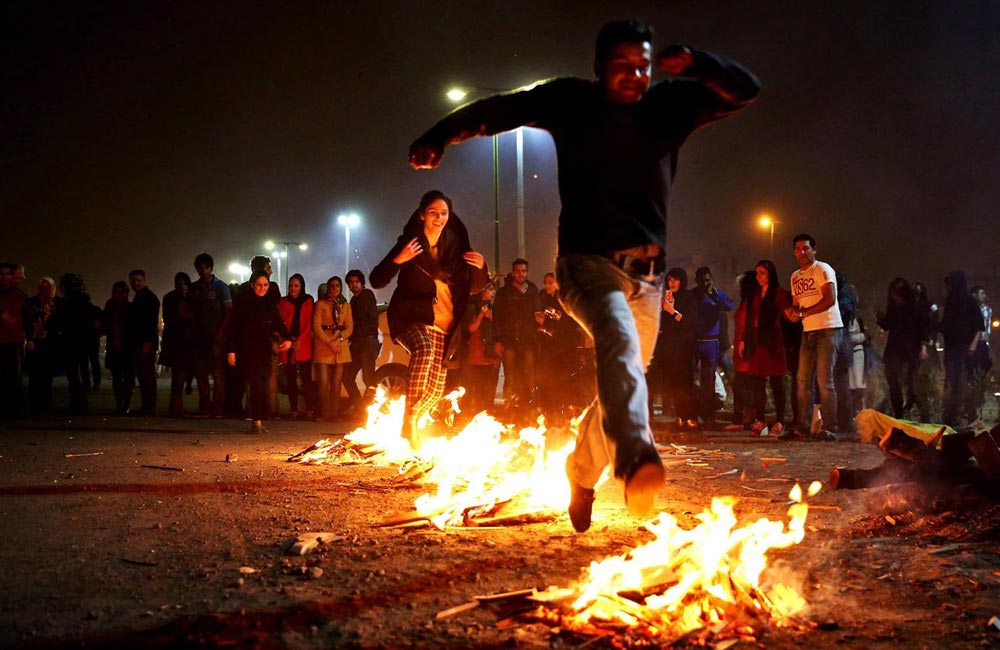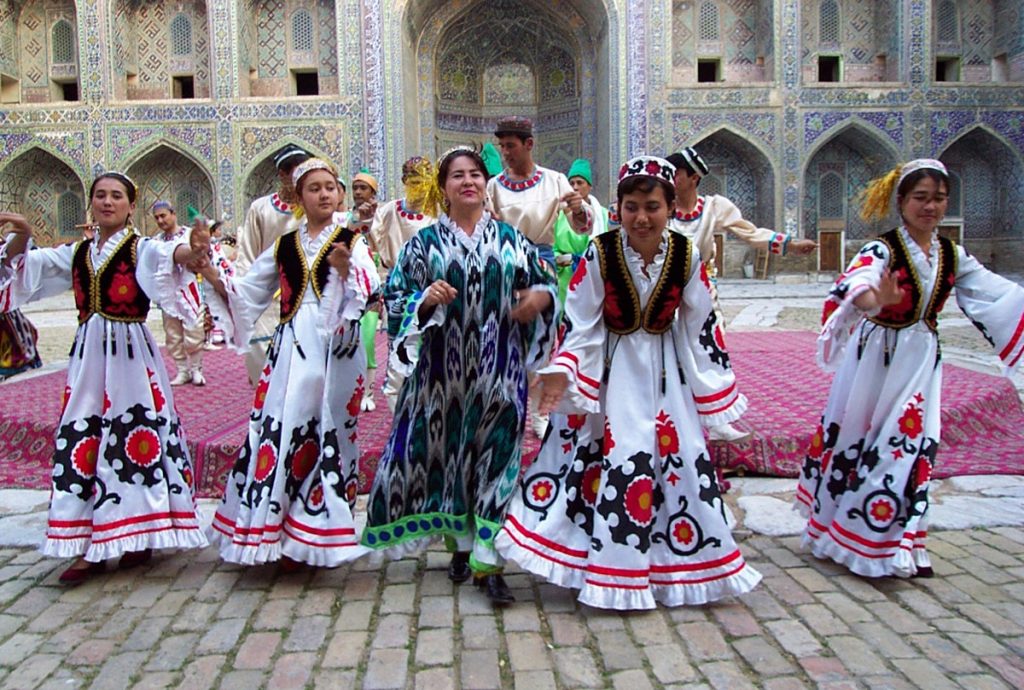Originally published by Ajam Media Collective on March 21, 2018.
Nowruz is an ancient festival marking the arrival of Spring that is celebrated in parts of the Middle East, Central Asia, South Asia, the Balkans, and East Africa. It dates back at least 3,000 years, and it was adopted and spread by the ancient Persian religion of Zoroastrianism, which the holiday is today often linked with. The Zoroastrian calendar was based on the passage of seasons, and Nowruz – which means “New Day” in Persian – is followed by the festival of Tirgan in summer, Mehregan in fall, and Yalda in winter.
Nowruz is a celebration of rebirth and renewal, of the end of winter and the flowering of the Earth that warm weather portends.
In this article, we’ll be taking a tour of Nowruz around the world to see some of the many ways its marked and the meanings it has taken on. We start by discussing the history of Nowruz, before proceeding country by country: Iran, Azerbaijan, Afghanistan, Central Asia, Kurdistan, the Balkans and Turkey, and finally, Tanzania.

Nowruz is often called the Persian New Year and is closely associated with Iran. But Nowruz is marked across many different countries, including in Afghanistan and Central and Southern Asia, among Kurds across the Middle East, and even in parts of the Balkans and on the Tanzanian island of Zanzibar (more on that soon!).
Even though Nowruz has ancient roots, the holiday has changed significantly over the thousands of years that it has been celebrated. Different regions have preserved or developed different traditions, and new ones have been added to the old ones. The beautiful thing about Nowruz is that it has taken different shapes everywhere it has reached, but it always marks the original message of rebirth and renewal.
The spread of Nowruz can be traced back to three primary historical factors. Firstly, the ancient influence of Persian imperial culture across much of Central and Western Asia, where Persian and Turkic communities have celebrated it for many centuries.
Secondly, Nowruz is linked to the adoption of Persian culture and poetry by medieval Islamic empires, like the Ottomans and the Mughals, who spread the holiday to Turkey, the Balkans and South Asia. The Mughal court officially celebrated Nowruz in India, while the Bektashi Sufi order, which was influential in the Ottoman realm, spread the holiday into Southeastern Europe.

In the past, Nowruz was much more widespread then it is now; for example the Islamic Umayyad and Abbasid dynasties are believed to have celebrated in the Arab world. The third factor in Nowruz’s spread is that migrants from Iran took the holiday with them as they traveled, including to places like Zanzibar where it was eventually adopted by locals as well.
Nowruz is also a religious holiday for many. In Zoroastrianism and the Baha’i Faith, Nowruz is marked as the new year. For many Muslims as well, Nowruz is an important day. The 6th Shia Imam, Imam Jaafar, is said to have encouraged the celebration of Nowruz with remembrance of the divine. This tradition is taken seriously by many, especially among Shia and Ismaili Muslims in India and Pakistan. Many Ismaili Muslims celebrate by distributing rice and sugar and painting boiled eggs. Some Shia Muslims observe the day as a fasting day.

For many, Nowruz is closely associated with Ali ibn Abu Talib, the first Shia imam and the fourth Sunni caliph. It is marked with great festivities by Sunni and Shia Muslims in Mazar-e-Sharif, where many believe he is buried. One famous story recounts that a gift of falooda, a sweet rose-flavored dessert, was sent to Imam Ali on Nowruz. When he found out the reason for the gift, he announced: “May every day be Nowruz then!”
Nowruz is a secular holiday for some, a religious holiday for others, and something in between for many more. Wherever it goes, Nowruz involves a lot of time spent with family and a lot of time eating food, and it usually begins with spring cleaning to welcome in the new year. Across many different countries, there are common foods, especially a wheat paste called samanu or sumalak that is usually prepared in a large oven together. There are also shared rituals like bonfires, as fire’s warmth is linked to life and health.
Nowruz is not without its politics, either. In parts of the Soviet Union, the holiday was banned for most of the 20th century, forcing millions to mark Nowruz underground. And in Syria, Turkey, and Iraq, Newroz has been repeatedly banned by Arab nationalist governments intent on suppressing Kurdish cultural expression, turning it into a powerful symbol of Kurdish thirst for azadi, or freedom. In Iran, the Islamic Republic initially banned Chaharshanbe Suri bonfires due to their alleged origin in Zoroastrian fire worship, but eventually relented.
Throughout it all, Nowruz has persevered as a popular expression of rebirth, joy, and love hinting at a shared Persianate cultural heritage deep below the surface across the region.

Iran
Nowruz is a two-week long holiday in Iran, one of the most important celebrations of the year. The Nowruz season begins on the last Tuesday before the New Year with Chaharshanbe Suri, when Iranians jump over bonfires in the streets to mark the end of the year. As Iranians leap over the fires, they chant “sorkhi-ye to az man, zardi-ye man az to” (“let your redness be mine, let my yellowness be yours”) to represent their wishes for good health (the redness, symbolizing warmth and strength) in the year to come and cleansing their bodies of sickness (the yellowness).

Historically Chaharshanbe Suri took place over the last three or four Wednesdays of the year. Chaharshanbe Suri is accompanied by Qashogh Zani, when people go door to door asking for gifts (often money or sweets) dressed in long chadors to cover their identity.
In the days leading up to Nowruz, bazaars overflow with holiday gifts as well as the seven elements that make up the traditional Nowruz spread that Iranians set up in their homes, called a Haft Seen(“Seven S’s”). Each of these begins with the letter “seen” (i.e. “s”), and they include: sabzeh (grass, for rebirth), senjed (dried fruit, for love) sib (apple, for beauty and health), seer (garlic, for health), samanu (for wealth and fertility), serkeh (vinegar, for wisdom that comes with age), and sumac (for the sunrise of a new day). Many also add mirrors, goldfish, coins, and flowers to Haft Seen displays.

Iranians spend Nowruz with family, and the traditional new year dinner is herbed white fish with rice. The thick green Ash Reshte stew is also a common Nowruz dish, as well as nokhodchi, a chickpea cookie. Many families also give out “eidi” to younger ones, a money gift to mark the new year. This is also the time when performers appear in blackface as Hajji Firuz, a traditional Nowruz character whose roots are linked to slavery, make their appearance in streets across Iran.
The Nowruz holiday ends with Sizdebedar (“13th to the door”), the 13th day after Nowruz when Iranians traditionally spend the day picnicking outside. In Iran, the countryside fills up with families leaving their urban comforts behind and eating food, smoking waterpipes, and dancing outside wherever they can find a space. Sizdebedar gatherings among Iranians abroad, meanwhile, can attract to tens of thousands to parks in cities like Los Angeles and San Francisco.
Iranian band Rastak performs a traditional Nowruz song.
Azerbaijan, Georgia, and Armenia
Novruz is a major national party in Iran’s northern neighbor Azerbaijan, where it is marked by huge bonfires across the country accompanied by music and dancing. For days before, Azeris will collect firewood in preparation. As the bonfire winds down, families and friends jump over it to burn all the bad things of the year past and to welcome in the new year clean and fresh.
Novruz in Azerbaijan is all about the food. A typical Azeri Novruz dish may include a heaping plate of rice pilav, dolma (grape leaves stuffed with lamb), and shekerbura, a sweet pastry made with walnuts or almonds. Neighbors share their creations with each other, and children go door to door singing folk songs and collecting sweets. Many houses also put up displays of səməni, grass wrapped in a red bow that marks the arrival of springtime. In the town of Qazax, one famous Novruz tradition involves crossdressing and dancing in the streets.
Novruz is also significant for the Azeri community in neighboring Georgia as well, where many perform traditional dances and young men ride horses through the streets. Wrestling competitions also feature prominently. In neighboring Armenia, meanwhile, many traditions similar to Nowruz are maintained in February during the Trndez holiday. These include lighting bonfires and, on a separate holiday, throwing water at friends and family, which was a common Nowruz festivity in Iran historically but today is less common.
Afghanistan
Nawroz is widely marked across Afghanistan, most commonly with Haft Mewa (“Seven Fruit”). Haft Mewa is a sweet dessert compote made from seven dried fruits and nuts, usually red raisins, black raisins, yellow raisins, senjid (the fruit of the oleaster tree), pistachio, dried apricot, and dried apple.
A Nawroz dinner in Afghanistan may include sabzi challow (spinach and rice) with rooster or white fish. The holiday is marked with the recitation of Persian poetry as well as plays on Nowruz themes, and in Afghanistan large games of bozkashi – polo played with a stuffed goat’s head – are played for many to watch. The preparation of samanoo is a must, and many women gather to help stir the sweet pudding – which must be stirred constantly for many hours during the preparation – and sing folk songs.
In Mazar-e-Sharif, Nawroz is closely linked to the red tulip festival, as the countryside fills with these beautiful red flowers and many enjoy picnicking around them. At the city’s Blue Mosque, meanwhile, Nawroz is the time for a festive flag-raising over the tomb where Imam Ali is believed to be buried.
Central Asia
In Tajikistan, Uzbekistan, Kazakhstan, Kyrgyzstan, and Turkmenistan, Nevroz or Nauryz is a major public holiday. Navroz is also marked by Turkic and Persian communities in western China, especially in Xinjiang province (also known as East Turkestan) which is a cultural part of Central Asia.
In Tajikistan, Tajiks clean their homes fastidiously in anticipation of the holiday, which is spent feasting with friends and wearing nice clothes. Public events often involve singing, dancing, and wrestling, in addition to huge games of bozkashi, a traditional sport similar to polo but using a lamb’s head. There is also a festive table called dastarkhon that is decorated with seven items beginning with the letter “s”. Some Tajiks also prepare Haft Mewa, as in Afghanistan.
In both Tajikistan and Kyrgyzstan, there is a tradition of filling empty vessels around the home with water on the eve of Navroz to bring in the holiday. This is linked to wishes for good health in the new year. Many light candles as well, demonstrating the importance of both water and fire in new year celebrations.

In Kazakhstan, many cities erect dastorkhan in large traditional yurts, used by nomads for centuries as they traveled across the land. Nauryz involves the Nauryz koshe, a holiday meal that consists of seven ingredients, usually including water, meat, salt, milk or yoghurt, and a grain. These ingredients symbolize seven virtues, and the meal is offered to guests and neighbors. In many towns, messengers travel among the houses and invite people to join the celebrations. In some places, people dress up like heroes from Kazakh folklore like Aldar Kose, Zhirenshe and Karashash. There’s also co-ed wrestling, people trying to say tongue-twisters (zhanyltpash) and riddle-solving (zhumbak).
Throughout Central Asia, Navroz is closely associated with samanu, called sumalak. Sumalak is a sweet wheat paste made from young wheatgrass which is soaked and prepared a week in advance. On the eve before Navroz, women gather around huge pots of sumalak stirring it for hours upon hours and singing folk songs until dawn. The sweet paste is then handed out to loved ones to spread around the joy of the new year.
Kurdistan
For Kurds across the Middle East, Newroz is intimately linked to the story of Kawa (also known as Kaveh) from the mythical Persian poem the Shahnameh. Kawa was a blacksmith who led an uprising against a tyrannical Assyrian king named Zahak and freed his people from Zahak’s oppressive rule. In commemoration of the victory, they say, Newroz was established and the victorious villagers leaped over bonfires to celebrate.
Among Kurds in Turkey, Iraq, and Syria, Newroz is deeply political due to the fact that its celebration has been for decades suppressed. As a result, the story of Kawa has taken on added urgency as asymbol of popular resistance to oppression. The bonfires lit in Kurdish Newroz celebrations in these countries are often spectacular displays, and hundreds or thousands will circle them to perform large line dances to mark the festivity.
Many Kurds go out into the countryside to mark Newroz and have picnics with families, celebrating the warmer weather and wearing bright, traditional Kurdish clothes to welcome Spring.

Albania, Kosovo, and Turkey
In Albania and Kosovo, “Dita e Sulltan Nevruzit” (the Day of Nevruz Sultan) is a national holiday closely linked to the Bektashi Sufi order. Nevruz is considered a pan-Albanian holiday dear to all and central to religious harmony. For followers of the Sufi order, Nevruz is marked as the commemoration of the birth of Imam Ali, the fourth Islamic caliph, while for secular Albanians its celebration is linked to the beginning of spring.
In Sufi tekkes (lodges) across Albania and Kosovo, Nevruz is a day when many visit and large meals of lamb are cooked to be shared with all who stop by. Many Sufi lodges carry out dhikr, or ritual remembrance and chanting, on the day.
Nevruz commemorations – and their links to Imam Ali’s birthday – are widespread among Bektashi Sufis and Alevis in countries outside of Albania as well, especially in Turkey. Celebrations like Mart Dokuzu, which means 9th of March, are linked to the Nevruz holiday, and often include visits to grave sites. In rural Anatolia, some Nevruz traditions include placing bowls of water throughout the house on Nevruz eve in the hope that one’s wishes come true. Across Anatolia, there are various commemorations linked to Nevruz that are different from region to region, but often include water, fire, and picnicking outside and wishing for luck in the year to come.
In many parts of southeastern Europe, especially those previously under Ottoman rule, Nevruz celebrations were often absorbed over time into Easter rituals. This is partially because of how similar celebrations can be: for example, the tradition of painted eggs exists in both. Until the mid-20th century, Nowruz celebrations were common in many parts of Bulgaria and Romania, especially among communities like Pomaks, Albanians, and Gagauz, and among Crimean Tatars in the Ukraine.
Tanzania
Of all the countries where Nowruz is celebrated, probably the least widely known is in Tanzania. About 1,000 years ago, a group of Iranians from Shiraz move to the island of Zanzibar off the coast of Tanzania and settled there. They were part of a larger wave of migration from Iran and the Persian Gulf region over the centuries to come that brought Zanzibar and Africa’s eastern coast generally into an intimate relationship with the Persian Gulf regions.
The Shirazis who settled in Zanzibar brought Nowruz with them, and over time Zanzibaris adopted the holiday under the name Mwaka Kogwa. The holiday is celebrated in July (Tanzania is in the Southern hemisphere after all!), and today it is celebrated as a new year festival with its own set of traditions.
The most well-known Makwa Kogwa takes place in the village of Makunduchi. There, men use banana stems to engage in mock fights with each other in order to air out the grievances from the past year and start the new year fresh. Women, meanwhile, sing songs in the fields around the village. The celebration includes large meals offered to any guest who passes by, as it is considered unlucky to be without a guest on the holiday. Like most Nowruz celebrations, Makwa Kogwa even includes a big bonfire.
These are just some of the many ways Nowruz is marked around the world today. What did we miss? Let us know in the comments!